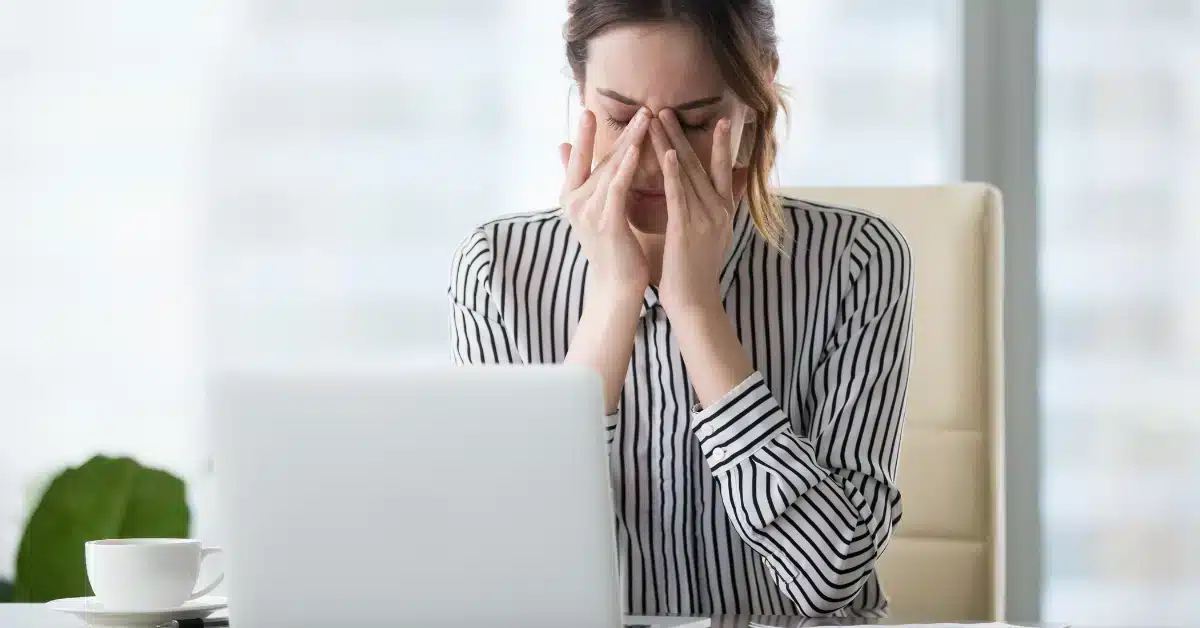Eye Strain Symptoms: Know the Signs
Eye strain is a fairly common condition.
It is usually caused by intense eye activity for long periods of time.
The American Optometric Association says that the severity of your discomfort might depend upon factors such as the time you spend looking at screens.
Additionally, whether or not you are astigmatic, farsighted, or nearsighted also affects your discomfort.
About 2 out of 3 Americans experience eye strain from using digital devices.
This article will discuss eye strain symptoms and ways to prevent them.
Symptoms
Eye strain symptoms in toddlers and adults are typically the same.
Children, like adults, may complain of headaches, eye pain, or tiredness.

Following are some common telltale signs of eye strain.
Watery eyes
Watery eyes mean that your eyes produce more tears than usual.
Tears are usually meant to keep the surface of the eyes moist.
But when produced in large quantities, they might cause discomfort.
Watery eyes are a common eye strain symptom.
Dry eyes
Dry eyes happen when your eyes do not produce enough tears.
Also, dry eyes occur when the eyes do not produce enough amount of the right kind of tears.
- Basal tears- Protect eyes from drying out, and damage to cornea
- Reflex tears-Triggered by external stimulus
- Emotional tears- Triggered by strong feelings
Researchers have found that people who use computers or digital devices, generally for prolonged periods, blink less.
This can cause dry eyes, which may contribute to eye strain.
Blurred or double vision
If you experience blurred or double vision, it can be a sign of eye strain.
This could be because your visual system is exhausted.
Sensitivity to light
Eye strain might also lead to sensitivity to light, also called photophobia.
People with lighter eye colors have lesser pigments than darker eyes.
Because these pigments protect the eyes against harsh lighting, light-colored eyes are more likely to be sensitive to light.
Headaches or migraines
Prolonged hours in front of a screen can often lead to eye strain called digital eyestrain.
This can lead to headaches and sometimes migraines.
Other symptoms
Apart from those mentioned above, some commonly observed symptoms of eye strain include the following:
- Aching, burning, or itchy eyes
- Dizziness
- Eye fatigue
- Stiffness and pain in neck and shoulders
- Red, irritated eyes
- Difficulty keeping the eyes open
- Difficulty concentrating
When to see a doctor
Some eye strain symptoms can be relieved at home.
But, sometimes, reaching out to a doctor on time is essential.
Consult your doctor if you feel discomfort in your eyes, severe headache, or changes in vision that do not go away with self-care.
Additionally, if you feel that the eye strain symptoms could be worsening because of an underlying condition, seek professional help.
Prevention Tips
Eye strain usually goes away once you rest your eyes enough.
But it is smarter to prevent eye strain before it occurs than finding a cure.
You can do so by taking these little measures.
Take frequent breaks
Resting your eyes after every 2 hours of strenuous eye activity for at least 15 minutes is suggested.
This helps your eyes to relax and refocus.
You can even try the 20-20-20 rule wherein every 20 minutes, you look at something 20 feet away for 20 seconds.
It helps relax your eyes and relieves eye strain.
Blink more often
Blinking makes sure your eyes are lubricated.
Therefore it is advised to blink periodically to avoid the sensation of dry eyes.
Reduce glare
Use an anti-glare screen on your monitor to reduce the glare from your computer screen and other light sources.

Adjust the lighting
Make sure you adjust the lighting of the room you are in to reduce the glare on surfaces, such as desks and walls.
It is advised to keep the room softly lit.
Also Read: You can go through the article, Clearing Your Vision: Tips and Techniques for Eye Strain Relief.
Limit screen time
It is crucial, especially for children who may not understand how longer screen time can affect their eyes.
Pick the appropriate eyewear
Invest in your eyewear if you wear spectacles or contact lenses and work for a long time in front of screens.
Ask your doctor to suggest the correct type of glasses or lenses for computer work.
You might also want to ask them about lens tints and coatings that could be helpful.
See a doctor if your eye strain symptoms do not disappear after resting your eyes.
Takeaway
Eye strain symptoms, digital or otherwise, usually include temporary pain, itching, watering, and several others.
Preventive measures and home remedies might be helpful in some cases.
But it is advisable to seek professional help if your condition persists or worsens over time.
Frequently Asked Questions
What does a strained eye feel like?
Strained eyes feel sore, itchy, tired, and burning. Dry or watery eyes, blurred or double vision, and headaches might also be signs of strained eyes.
How long do eye strains last?
Eye strain usually doesn’t last very long. It subsides once you rest your eyes or take other steps to relieve them. Consult your doctor is recommended if it sustains for an abnormally long time.
Is there a test for eye strain?
Eye strain is diagnosed by studying your symptoms, followed by a comprehensive eye exam. Doctors recommend annual eye exams to make your eyes remain healthy.
Does eye strain damage vision?
Eye strain does not cause any severe damage to the eyesight. However, it can cause blurred or double vision, which can be fixed once you have rested enough. It can also make you feel tired and affect your ability to concentrate.
WowRx uses only high-quality sources while writing our articles. Please read our content information policy to know more about how we keep our content reliable and trustworthy.






